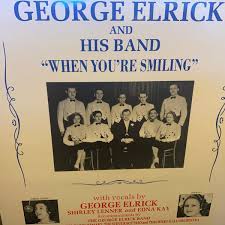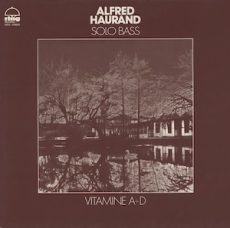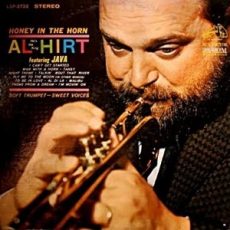
Daily Dose Of Jazz…
George Connell Elrick was born on December 29, 1903 in Aberdeen, Scotland. His first ambition was to be a doctor but financial constraints prevented this. Still in his teens, he began playing drums for local dance bands and by 1928 had formed his own band, the Embassy Band. The group swept the prizes in the All-Scottish Dance Band Championship that year.
Turning professional, George moved to London, England where he became friends with the crooner Al Bowlly, and began singing himself. He joined the Henry Hall Orchestra as a vocalist and drummer and their 1936 recording of The Music Goes Round and Round made him a star. Leaving Hall in 1937 he formed his own band, and two years later began his solo career, which was moderately successful through the years of World War II.
In 1948, he took a touring revue around Britain, and was asked by the BBC to stand in for two weeks as disc-jockey on the morning record request show Housewives’ Choice. The temporary job lasted almost twenty years, as his Scottish accent and liberal use of catchphrases became highly popular.
In later years, he became something of an impresario and acted as an agent for numerous musicians such as Mantovani. He was a member of the Grand Order of Water Rats, and was also a life member of the Variety Club of Great Britain.
Drummer George Elrick, who published his autobiography titled Housewives’ Choice: The George Elrick Story, died on December 15, 1999.
More Posts: bandleader,drums,instrumental,jazz,music,vocals

Daily Dose Of Jazz…
George James was born in Boggs, Oklahoma on December 7, 1906. His career didn’t begin until the late 1920s joining the bands of Charlie Creath and Johnny Neal. He moved to Chicago, Illinois in 1928, where he played with Jimmie Noone, Sammy Stewart, Ida Marples, Jabbo Smith, and Bert Hall.
In 1931 through the first quarter of 1932 he toured with Louis Armstrong, and at the end of the tour he remained in New York City. There he joined the Savoy Bearcats and later played with Charlie Turner’s Arcadians. By the middle of the decade Fats Waller assumed leadership of the Arcadians, and James played under him until 1937.
Finishing the decade playing in the Blackbirds Revue, early in the 1940s he worked with James P. Johnson, Benny Carter, Teddy Wilson, and Lucky Millinder, and led his own bandhttps://notoriousjazz.com/jazz-type/swing/daily-dose-of-jazz-3977↗ in 1943-44. Later in the decade James played with Claude Hopkins and Noble Sissle.
He was active both as a leader and a sideman into the 1970s, playing with Clyde Bernhardt and the Harlem Blues and Jazz Band in that decade. Saxophonist, clarinetist, and flautist George James died on January 30, 1995 in Columbus, Ohio.
More Posts: bandleader,clarinet,flute,history,instrumental,jazz,music,saxophone

Daily Dose Of Jazz…
Ali Haurand was born Alfred Josef Antonius Haurand on November 15, 1943 in Viersen, Germany. After an apprenticeship as a confectioner and a business manager, he studied from 1966 to 1973 at the Folkwang School and the Rhineland Music Academy. He initially played with his own trio and from 1967 in the trio and quintet of pianist George Maycock. In 1968 he also toured with Philly Joe Jones, Jacques Pelzer, René Thomas and Jan Huydts.
He performed with Ben Webster, Don Byas, John Handy, Bobby Jones and Wilton Gaynair. This was followed by his own groups, Third Eye, the European Jazz Quintet with Leszek Zadlo, Gerd Dudek, Alan Skidmore and Pierre Courbois. Together with Alan Skidmore and Tony Oxley, they formed the trio SOH. Haurand played with his long-time companions, the saxophonist Gerd Dudek and the pianist Rob van den Broeck, in the formation The Trio.
Since 1982, the European Jazz Ensemble, which he formed out of the European Jazz Quintet with varying lineups that included Allan Botschinsky, Stan Sulzmann, Joachim Kühn and Daniel Humair. In the 2000s, he took part in several jazz and poetry projects.
For decades he was a presenter and consultant to the WDR television jazz editorial team, and for twelve years he was artistic director of the Düsseldorf Jazz Rally. From 1987 he was the founder, director and organizer of the Viersen Jazz Festival until 2014. For over 20 years he organized the jazz concerts in the Süchtelner Weberhaus.
Double bassist and bandleader Ali Haurand, who was also a television presenter, music producer and festival manager, died on May 28, 2018.
More Posts: bandleader,bass,history,instrumental,jazz,music

Daily Dose Of Jazz…
Alois Maxwell Hirt was born on November 7, 1922 in New Orleans, Louisiana to a police officer father. At the age of six, he got his first trumpet, which had been purchased at a local pawnshop. He played in the Junior Police Band with friend Roy Fernandez, the son of Alcide Nunez. By 16 he was playing professionally with his friend Pete Fountain, while attending Jesuit High School. During this time, he was hired to play at the local horse racing track, beginning a six-decade connection to the sport.
1940 saw Al in Cincinnati, Ohio studying at the Cincinnati Conservatory of Music with Dr. Frank Simon. After a stint as a bugler in the Army during World War II, he performed with various swing big bands, including those of Tommy Dorsey, Jimmy Dorsey, Benny Goodman, and Ina Ray Hutton.
In 1950 Hirt became the first trumpet and featured soloist with Horace Heidt’s Orchestra and after several years on the road he returned to New Orleans working with various Dixieland groups and leading his own bands. He soon signed with RCA Victor and posted twenty-two albums on the Billboard charts in the 1950s and 1960s. He recorded the theme for the 1960s television show The Green Hornet, with arranger and composer Billy May.
From the mid-1950s to early 1960s, Hirt and his band played nightly at Dan’s Pier 600, hosted the hour-long television variety series Fanfare, as the summer replacement for Jackie Gleason and the American Scene Magazine, and would go on to play for Pope John Paul II.
Trumpeter and bandleader Al Hirt died of liver failure on April 27, 1999 at the age of 76, after having spent the previous year in a wheelchair due to edema in his leg.
More Posts: bandleader,history,instrumental,jazz,music,trumpet

Daily Dose Of Jazz…
Christopher Burnett was born in Olathe, Kansas on November 2, 1955 and grew up in a military family that moved often before settling in the Kansas City area. He was exposed to music growing up as his mother introduced him to the piano and he was a member of the youth choir at his church. He took up saxophone and clarinet in his school band. After high school, he enlisted in the U.S. Army Music Program where he performed and pursued higher education, studying at the Armed Forces School of Music, Webster University, Missouri’s Columbia College, Berklee College of Music, and American University.
Spending 22 years in the military, Chris rose to the rank of 1st Sergeant in the position of Enlisted Bandleader, staff and faculty assignment at the Armed Forces School of Music, and the leading Chief Petty Officer of the NATO Band in Naples, Italy. He served as NATO Ceremonial Band Conductor, directed the jazz band, played the lead alto saxophone chair with the West Point Military Academy Band’s Jazz Knights, and a featured soloist with the Hof Symphony Orchestra in Germany.
After leaving the military Burnett continued to teach, holding the position of director of the jazz ensemble program and adjunct lecturer at Missouri University of Science and Technology, formerly University of Missouri-Rolla, where he worked as an Adjunct Lecturer for a decade.
He has performed with artists like Bobby Watson, Will Matthews, Marcus Hampton, Ahmed Alaadeen, and many more. Burnett is the Founder and Artistic Director of KC Area Youth Jazz and along with colleagues Erica Lindsay and Sumi Tonooka is a co-founder of the large independent recording label, Artists Recording Collective.
He has held residencies at the historic Drum Room and the Black Dolphin in Kansas City, and appeared as a guest artist and clinician for the Northwest Missouri State Jazz Festival. He released his debut album as a leader, Time Flies in 2013, Firebird in 2014, in 2021 The Standards, Vol. 1, and Live at The Drum Room in Kansas City in 2022.
More Posts: bandleader,educator,history,instrumental,jazz,music,saxophone



